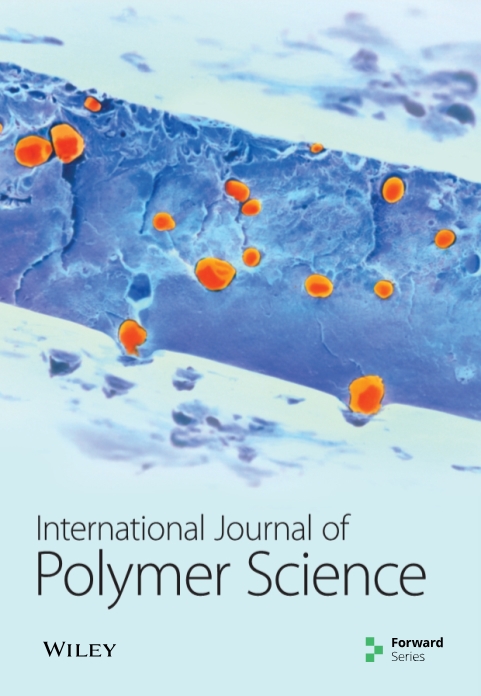过氧化碱漂白后缓冲溶液中亚氯酸盐的分离与表征
IF 4.4
4区 化学
Q2 POLYMER SCIENCE
引用次数: 2
摘要
植物是纤维素的主要来源。本文旨在通过化学处理从深海氧南花中分离纤维素。考察了原料纤维(ROA)、脱蜡纤维(DOA)、碱处理纤维(AOA)和漂白纤维(BOA)的热行为、官能团、化学组成、结晶度和形貌。采用TGA、FTIR、DSC、DTA、XRD、SEM进行表征。通过测定纤维素、半纤维素、木质素和灰分的含量,考察了化学处理的效果。经过打蜡、碱处理和碱过氧化物漂白等步骤去除非纤维素组分,然后在缓冲溶液中加入亚氯酸盐,使ROA中的纤维素含量从49.26±0.13 wt%提高到86.01±0.02 wt%。BOA样品中纤维素和全新纤维素的含量最高,产率分别为86.01±0.02 wt%和97.61±0.17 wt%。与AOA和BOA相比,ROA具有更高的半纤维素(21.31±0.15 wt%)、木质素(20.63±0.12 wt%)和灰分(3.30±0.11 wt%)含量。XRD数据显示,每次处理后结晶度都发生了变化。由于结晶纤维素含量高,XRD结果表明BOA的结晶度指数(CrI)为59.89%,峰强度高于AOA、DOA和ROA。FTIR峰强度依次为ROA、DOA、AOA、BOA,说明预处理使半纤维素和木质素逐渐从深海草纤维中去除。TGA, DTG, DTA和DSC数据也证实了BOA由于纤维素含量高而具有最高的热稳定性。扫描电镜分析表明,由于化学处理,表面形貌发生了变化。这些结果证实,通过化学预处理,可以得到大量的纤维素。尽管埃塞俄比亚普遍种植着Oxytenanthera abyssinica,但对其进行的研究很少,也没有从植物中分离和表征纤维素的工作。因此,这项工作的发现将鼓励研究人员将深海氧南花作为纤维素的一种来源,用于各种应用,包括制造纤维素纳米晶体、聚合物基质生物过滤器、绿色生物复合增强剂和水凝胶合成。本文章由计算机程序翻译,如有差异,请以英文原文为准。
Isolation and Characterization of Natural Cellulose from Oxytenanthera abyssinica (Lowland Ethiopian Bamboo) Using Alkali Peroxide Bleaching Stages Followed by Aqueous Chlorite in Buffer Solution
Plants are the primary sources of cellulose. This paper is aimed at isolating cellulose from Oxytenanthera abyssinica via chemical treatments. The thermal behavior, functional group, chemical composition, crystallinity, and morphology of raw (ROA), dewaxed (DOA), alkali-treated (AOA), and bleached (BOA) fibers were examined. TGA, FTIR, DSC, DTA, XRD, and SEM were used for characterization techniques. The effects of chemical treatments were examined by determining the content of cellulose, hemicellulose, lignin, and ash. The cellulose content in the ROA improved from
49.26
±
0.13
wt% to
86.01
±
0.02
wt% due to the removal of noncellulose components using waxing, alkali treatment, and bleaching with alkali peroxide bleaching stages followed by aqueous chlorite in buffer solution. The highest content of cellulose and holocellulose was exhibited in the BOA samples with a yield of
86.01
±
0.02
wt% and
97.61
±
0.17
wt%, respectively. ROA had greater hemicellulose (
21.31
±
0.15
wt%), lignin (
20.63
±
0.12
wt%), and ash content (
3.30
±
0.11
wt%) in comparison to AOA and BOA. The XRD data showed a change in crystallinity after each treatment. Because of the high amount of crystalline cellulose, the XRD results revealed that BOA has a higher crystallinity index (CrI) (59.89%) and peak intensity than AOA, DOA, and ROA. The strength of the FTIR peaks increased in the order of ROA, DOA, AOA, and BOA, indicating that pretreatment causes hemicellulose and lignin to be gradually removed from the Oxytenanthera abyssinica fiber. The TGA, DTG, DTA, and DSC data also confirmed that BOA has the highest thermal stability due to the high content of cellulose. The SEM analysis showed a morphological change in the surface due to chemical treatment. These results confirmed that through chemical pretreatment, a high amount of cellulose was produced from Oxytenanthera abyssinica. Even though Oxytenanthera abyssinica is commonly grown in Ethiopia, few studies have been done on it, and no works have been carried out to isolate and characterize cellulose from the plant. Thus, the findings in this work will encourage researchers to use Oxytenanthera abyssinica as a source of cellulose for various applications, including the manufacture of cellulose nanocrystals, polymer matrix biofilters, green biocomposite reinforcing agents, and hydrogel synthesis.
求助全文
通过发布文献求助,成功后即可免费获取论文全文。
去求助
来源期刊

International Journal of Polymer Science
POLYMER SCIENCE-
CiteScore
6.10
自引率
0.00%
发文量
55
审稿时长
>12 weeks
期刊介绍:
The International Journal of Polymer Science is a peer-reviewed, Open Access journal that publishes original research articles as well as review articles on the chemistry and physics of macromolecules.
 求助内容:
求助内容: 应助结果提醒方式:
应助结果提醒方式:


